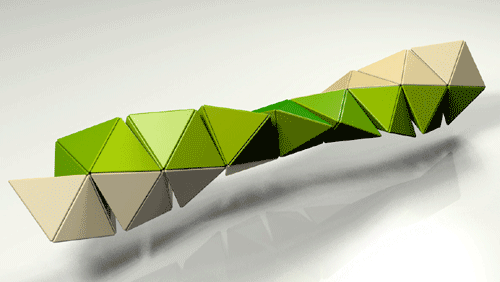2. Three Combinations
I examined the following combinations: a) rotation + translation which I will call Swing Translation, b) rotation + rotation (different axis) this is called Swing Rotation and c) rotation + scaling, Swing Scaling.
The purpose of this examiation was to see whether it could lead to designs or objects in which a combined transformation is a generating element.
A first remark maybe that we know representations of all three combinations: the helix, the moebius strip and the spiral. In this article I will focus on Swing Translation.
3. Swing Translation
3.1 Basic Principle. Combining the two transformations rotation and transformation can be done in a few different ways. We will start with the restriction that the direction of translation has to be along the rotational axis. Moving a point continuously this way in 3-dimensional space will result in a helix. But as with the tilings we will first use this transformation with discontinuous steps to build 3D objects.
As an example we start with a basic shape which consists of two connected tetrahedra (Figure 5 left). Like in tilings we add a next element to the first one. When we combine them face to face as in Figure 5 (middle), you will see that the transformation which is needed to go from the first double-tetrahedron to the second is a combination of a rotation and a translation. Going on with this process will result in the well known tetrahelix (Figure 5 right) [2].

Figure 5: Tetrahelix.

Figure 6: Tetrahelix - Basic element 3 tetrahedra.


Figure 7: Tetrahelix - Basic element 4 tetrahedra.